By location
Ancient Greece and Rome
Similar foods are documented in Ancient Greek cuisine: itrion (ἴτριον) was a thin biscuit/cake made with sesame seeds and honey, [1] the Cretan koptoplakous (κοπτοπλακοῦς) or gastris (γάστρις) was a layer of ground nuts sandwiched between two layers of sesame crushed with honey. [2] Herodotus also mentions "sweet cakes of sesame and honey", but with no detail. [3] The Kopte sesamis (κοπτὴ σησαμίς), or simply κοπτὴ, was a cake made from pounded sesame, [4] only the ingredients are known and not the recipe, but historians think that it may was similar to the modern Greek sesame seed sweet (pasteli) which is made from the same ingredients. [5]
Greece and Cyprus
In modern Greece and Cyprus, sesame seed candy is still baked and called pasteli (παστέλι). It is generally a flat, oblong bar made with honey and often including nuts. Though the modern name pasteli is of Italian origin. [6] On the island of Rhodes, a similar candy exist and is called melekouni (μελεκούνι). [7]
China
Sesame seed candy is called Hei Zhima Su (lit. Black Sesame Crisp) in Chinese. Traditionally it is made with nuts (including peanuts, almonds, and walnuts) or dried fruits (including raisins and dried goji). Traditionally the sweet is made primarily with black sesame. [9]
Vietnam
A variety of sesame seed candy containing peanuts, alongside sesame seeds and granulated sugar, is produced in the central Quảng Ngãi province where it is referred to as Kẹo Gương. It is believed to have been produced in the region for more than 400 years. [10]
Iran
In Iran's Mazandaran Province, it is a popular local candy made in various festivities such as Nowruz and Yalda night. It is usually made as thin layers and may contain walnuts, almonds, pistachios or other nuts.

Dessert is a course that concludes a meal. The course consists of sweet foods, such as cake, biscuit, ice cream and possibly a beverage such as dessert wine and liqueur. Some cultures sweeten foods that are more commonly savory to create desserts. In some parts of the world there is no tradition of a dessert course to conclude a meal.
Greek cuisine is the cuisine of Greece and the Greek diaspora. In common with many other cuisines of the Mediterranean, it is founded on the triad of wheat, olive oil, and wine. It uses vegetables, olive oil, grains, fish, and meat, including pork, poultry, veal and beef, lamb, rabbit, and goat. Other important ingredients include pasta, cheeses, lemon juice, herbs, olives and olive oil, and yogurt. Bread made of wheat is ubiquitous; other grains, notably barley, are also used, especially for paximathia. Common dessert ingredients include nuts, honey, fruits, sesame, and filo pastries. It continues traditions from Ancient Greek and Byzantine cuisine, while incorporating Turkish, Balkan, and Italian influences.

Halva is a type of confectionery originating from Persia and widely spread throughout the Middle East and South Asia. The name is used for a broad variety of recipes, generally a thick paste made from flour, butter, liquid oil, saffron, rosewater, milk, cocoa powder, and sweetened with sugar.

Tahini or tahina is a Levantine condiment made from toasted ground sesame. Its more commonly eaten variety comes from hulled sesame, but unhulled seeds can also be used for preparing it. The latter variety has been described as slightly bitter, but more nutritious. It is served by itself or as a major ingredient in hummus, baba ghanoush, and halva.
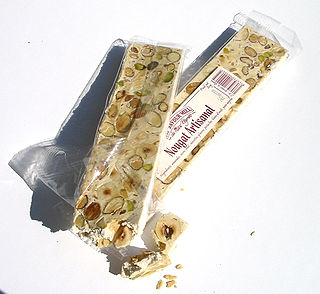
Nougat is a family of confections made with sugar or honey, roasted nuts, whipped egg whites, and sometimes chopped candied fruit. The consistency of nougat is chewy, and it is used in a variety of candy bars and chocolates. The word nougat comes from Occitan pan nogat, seemingly from Latin panis nucatus 'nut bread'.
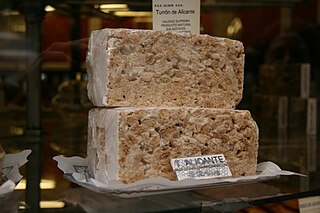
Turrón, torró or torrone is a southwest European and Moroccan nougat confection, typically made of honey, sugar, and egg white, with toasted almonds or other nuts, and usually shaped either into a rectangular tablet or a round cake. Turrón is usually eaten as a dessert food around Christmas in Spain and Italy. It is also popular in Portugal, Morocco, and Latin America.

Kuih are bite-sized snack or dessert foods commonly found in Southeast Asia and China. It is a fairly broad term which may include items that would be called cakes, cookies, dumplings, pudding, biscuits, or pastries in English and are usually made from rice or glutinous rice. In China, where the term originates from, kueh or koé (粿) in the Min Nan languages refers to snacks which are typically made from rice but can occasionally be made from other grains such as wheat. The term kuih is widely used in Malaysia, Brunei, and Singapore, kueh is used in Singapore and Indonesia, kue is used in Indonesia only, all three refer to sweet or savoury desserts.

Brittle is a type of confection consisting of flat broken pieces of hard sugar candy embedded with nuts such as pecans, almonds, or peanuts, and which are usually less than 1 cm thick.

Dragon's beard candy or Chinese cotton candy or Longxusu is a handmade traditional art of China. It is a traditional Chinese confectionary similar to floss halva or Western cotton candy, which can be found in many Chinese communities. Dragon's beard candy was initially created in China, but soon spread in popularity in other parts of East Asia and South East Asia, becoming a regional delicacy in South Korea in the 1990s, and Singapore in the 1980s, as well as more recently in Canada, and the United States.
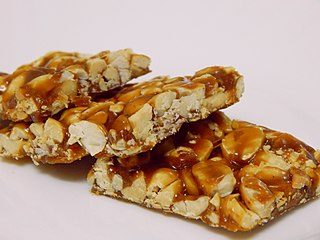
Chikki is a traditional Indian sweet (brittle) generally made from nuts and jaggery/sugar. There are several different varieties of chikki in addition to the most common groundnut (peanut) chikki. Each variety of chikki is named after the ingredients used, which include puffed or roasted Bengal gram, sesame, puffed rice, beaten rice, or khobra, and other nuts such as almonds, cashews and pistachios.

Somali cuisine was influenced by many different countries mainly due to trade, but traditionally also varies from region to region due to the expansive landmass Somalis inhabit. It is the product of Somalia's tradition of trade and commerce. Some notable Somali specialties include kimis/sabaayad, canjeero/lahoh, xalwo (halwa), sambuusa (samosa), bariis iskukaris, and muqmad/odkac.
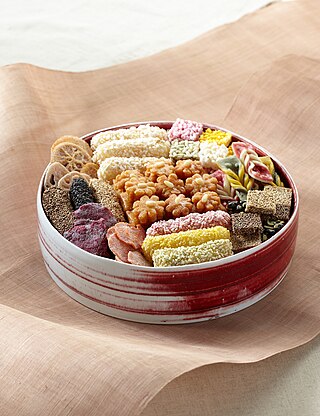
Hangwa is a general term for traditional Korean confections. With tteok, hangwa forms the sweet food category in Korean cuisine. Common ingredients of hangwa include grain flour, fruits and roots, sweet ingredients such as honey and yeot, and spices such as cinnamon and ginger.

Baklava is a layered dessert made of filo pastry sheets, filled with chopped nuts, and sweetened with syrup or honey.
The following outline is provided as an overview of and topical guide to chocolate:
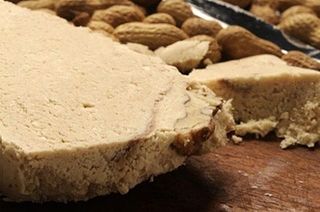
Mantecol is the brand name of a typical dessert of the cuisine of Argentina, a sort of semi-soft nougat made from peanut butter. It was originally created and marketed in the 1940s by the confectionery company Georgalos, founded by a Greek immigrant, Miguel Georgalos, who took the inspiration in a dessert of Greek cuisine, the halva.
Tilsakri is a dessert or confection originating in India. It is a dry sweet made of sesame seeds (til) or peanuts and jaggery. The til is cooked in the raw sugar syrup and set in thin layers, which can be stored for months. Tilsakri is also used as a Gajak, ie. any food item which is eaten after alcohol consumption to change the taste of the palate.


















